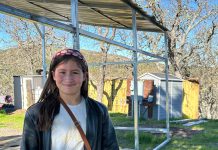Hollister
– In an effort to ensure a higher graduation rate for incoming
ninth-grade students and foster a fondness for the classroom, San
Benito High School has put together a plan that educators hope will
keep freshmen in school and in touch.
Hollister – In an effort to ensure a higher graduation rate for incoming ninth-grade students and foster a fondness for the classroom, San Benito High School has put together a plan that educators hope will keep freshmen in school and in touch.
Dropout rates have been thrust into the national limelight recently as the subject of numerous studies and articles attempting to gauge exactly how many students are leaving school and where they are going. Even if they don’t “drop out” in the traditional sense, public schools are affected when students transfer or move, including SBHS.
“All around the country people are asking ‘What’s happening to our ninth-graders?'” said SBHS Superintendent Jean Burns Slater, who announced the support plan at the June 21 board meeting.
Slater presented numbers tracking how many students have graduated from SBHS since 2003. For the past four years, roughly 150 fewer students have graduated than entered SBHS as freshmen, but not all of those lost students are what people typically think of as “drop-outs.”
“For example, we have a lot of students starting public high school as freshmen after private schools or home schooling,” Slater said. “But if a few months go by and they’re not doing well, sometimes their parents will put them back into private school.”
Students also move, go to a continuation school or choose to go to community college instead.
“In the school system where I used to work … sometimes we would graduate more special education students than ‘gifted’ students,” Slater said. “A lot of times they don’t do well in the comprehensive high school setting. They have other plans and they move on.”
Still, according to the 2005 California Healthy Kids Survey – a study all California schools participate in that gauges student health and behavior in a variety of areas – only 12 percent of SBHS freshman felt they were afforded “opportunities for meaningful participation” in campus life. And students who don’t feel they can participate in school are less likely to attend and less likely to perform well academically, educators say.
“Adolescents need to be connected,” Slater said. “They want a place where they can fit in but they also need to be unique. Whether it’s in a teacher’s classroom or a corner of the quad, if they have a place where they can eat their lunch and be themselves, they’ll know that people care about them and that what they contribute to the school is meaningful.”
The support plan lists 30 steps educators will take to keep freshmen on the straight and narrow, addressing everything from study skills and behavior to club involvement and parent education, some of which are already being implemented.
“I know these might seem like lofty goals,” Slater said. “But I think if we all focus on our ninth-graders we will be able to see progress in a year.”
The idea is to start preparing students for their high school careers before they so much as purchase their ‘Baler gym shorts. As early as seventh grade, educators hope to begin preparing students for the rigors of high school courses, homework and the California High School Exit Exam.
“By the time these kids get to the high school, learning is sometimes the last thing on their mind,” SBHS Assistant Principal Duane Morgan said. “They just think ‘Look at all these girls!’ or ‘Look at all these boys!’ or ‘Wow, football!'”
Because the move from a campus with a few hundred students at most to one with nearly 3,000 can be a little daunting for freshmen, they can wind up in trouble.
“We definitely see more freshmen in our offices than students from any other grade level,” Morgan said. “A lot of times they just haven’t learned the subtle nuances of getting along with people.”
Once freshmen are on campus and ready to go, acclimating them to the difficulty of high school work can be a challenge. To combat this, study skills will be incorporated into their ninth-grade science class and special tutorials will be established for ninth-graders.
“A lot of schools have special ninth-grade curriculum developed to help their students adjust,” Slater said. “We think incorporating study skills into science class will work very well, because in science you develop a hypothesis and test it. It’s a great, higher-order thinking kind of course.”
Many times, students aren’t the only ones who need to adjust to high school life – parents might need a little extra help, as well. The support plan calls for parent education seminars on topics such as “Understanding your Adolescent” and “Adolescents and the Law,” parent support groups and special parenting education classes if their student becomes suspended.
“Parents are the absolutely most important part of a student’s education,” said Chuck Schallhorn, psychology teacher and Social Sciences Department Chair. “We have extremely caring teachers, but if mom and dad can’t or won’t pay attention and make sure their children get to school, teachers can only do so much.”
Educators also plan on supporting clubs and student activities that will appeal to ninth-graders, encouraging special traditions that students can observe throughout their high school careers, and making sure that students connect with older students and adults early on.
“It’s easy to feel like a small fish in a big pond, but if someone knows you and calls you by name, it really, really makes a big difference,” Schallhorn said.
Danielle Smith covers education for the Free Lance. Reach her at 637-5566, ext. 336 or ds****@***********ws.com.









